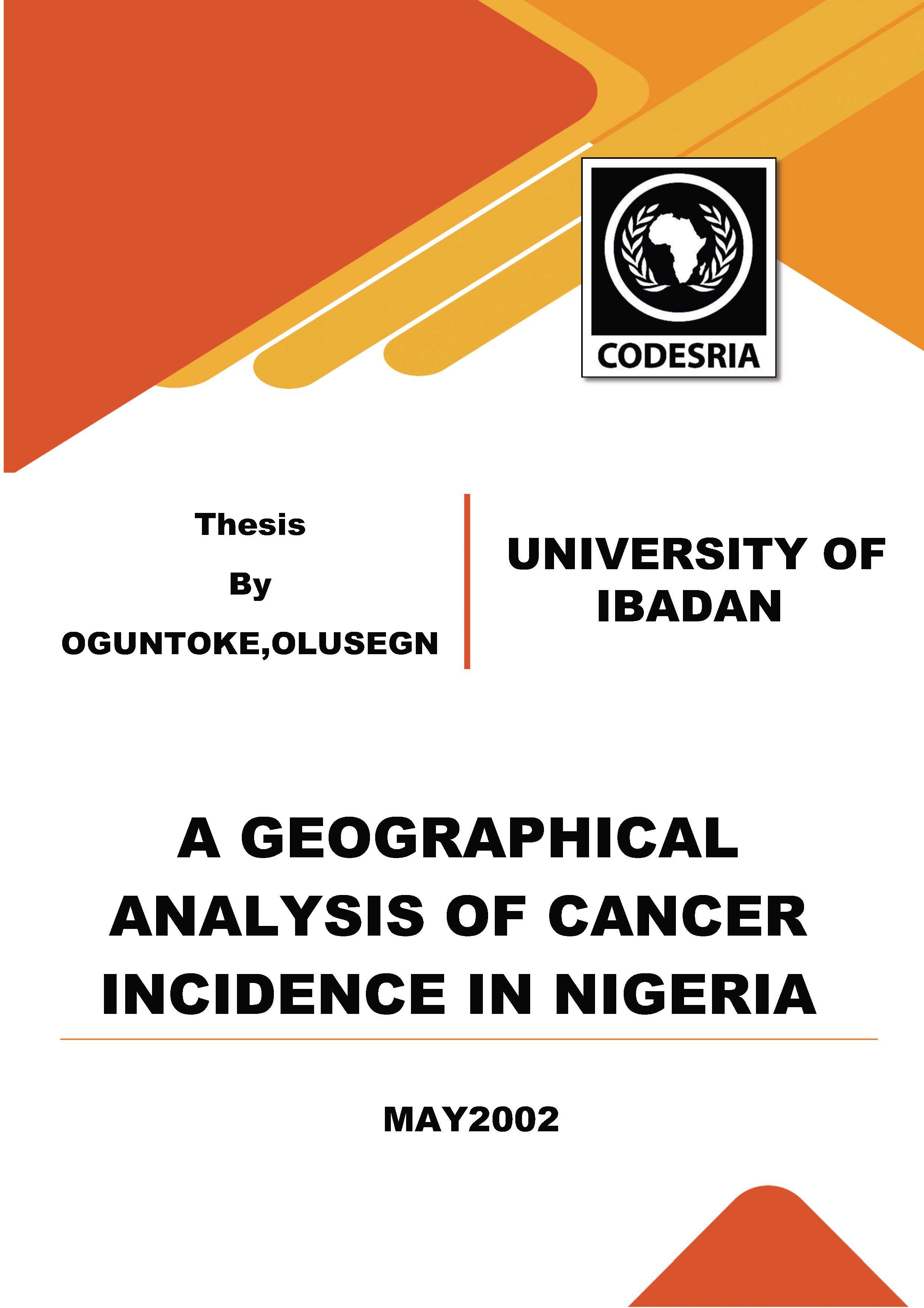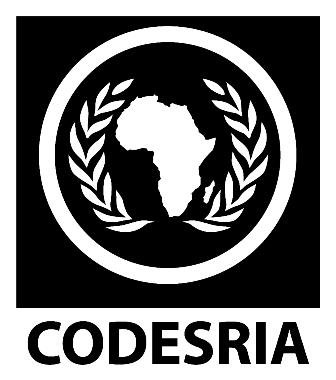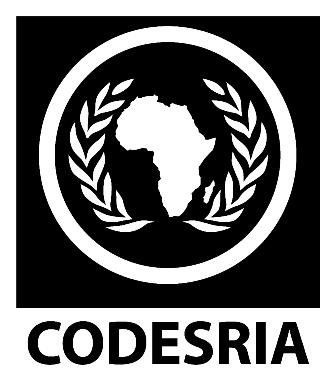A GEOGRAPHICAL ANALYSIS OF CANCER INCIDENCE IN NIGERIA
Mots-clés :
GEOGRAPHICAL ANALYSIS, CANCER, INCIDENCE, NIGERIASynopsis
The scarcity of geographical studies of non-communicable diseases (NCDS) is noticeable in the sub-Saharan Africa, particularly Nigeria. This situation arises from the view that the noncommunicable diseases are exclusively health problems of the advanced societies of the world. However, the scourge of these diseases especially cancer, is severe in this part of the world due to a graduai but. significaht epidemiological trànsition going on in the third world Countries. It is evident that all shades of lifestyles common in the advanced societies are already imported into Nigeria.
The present study is a comprehensive analysis of the spatial and temporal patterns of major cancer groups in Nigeria in order to explain their associative risk factors. To achieve these objectives, the study (i) identifies and analyses the spatial patterns of cancer groups at the regional and intra-urban Jevels; (ii) analyses the socio-demographic characteristics of cancer patients; (iii) identifies and compares the significant socio-economic, pathogenic and environmental risk factors associated with the cancer patterns and (iv) examines the Nigerian cancer profile over time and (v) analyse the trend of the specific cancer groups from 1960 to 1996.
The conceptual framework of this study is the ecological model of disease causation within the ambit of the epidemiological transition theory. Epidemiological Transition theory provided the basis for the shift of attention from predominantly infectious-parasitic diseases to the chronic-degenerative ones due to the transformation of the socio-demographic structure of the society. The ecological model of disease causation focuses the spatial variation in the occurrence of diseases due to variations in risks concentration in specific places.
The study is based on retrospective data on cancer morbidity (1960-1996) collected from the 5 existing National Cancer Registries at Ibadan, Ilorin, Ile-Ife, Enugu and Zaria. The bio-data: age, sex, marital status, occupation, and other vital information such as cancer site, and residency were collected on each cancer patient. While the bio-data provided information for the sociodemographic and lifestyles characteristics of the patients, the residential addresses were aggregated to portray the spatial pattern of cancer incidence. Data on the parameters of urbanisation, socio-economic development, demographic factors and pathogenic conditions of the 30 States and the Federal Capital Territory (FCT) in Nigeria were retrieved from the annual reports of the relevant Ministries and Agencies. These parameters were utilized to explain the regional pattern of cancer groups in Nigeria.
Primary data employed to explain the intra-urban pattern of cancer in Ile-Ife were collected through a household survey conducted to elicit information on the socio-environmental characteristics of the selected areas. In addition, data on the bio-chemical quality of water sources were collected from a report made available at the Obafemi Awolowo University, Ile-Ife.
This study revealed that ail the cancer sites identified by the WHO disease classification were reported in Nigeria with varying magnitudes. The cancer sites grouped into 15 categories (excluding the ill-defined sites) tend to portray distinct socio-emographic characteristics. Sex differentials in cancer occurrence showed that, apart from cancer groups that are exclusive to the male and female physiology, the males were generally afflicted more (54.4 percent) than their female counterparts. Age cohort 46-60 accounted for the highest occurrence (30.0 percent) of cancers, followed by age cohort 30-45. These two age cohorts which constitute the nations labour force selectively suffered from cancers.
There are significant variations in the temporal characteristics of cancer groups in Nigeria. Whereas the overall cancer portrays an increasing trend into the future, the specific cancer groups that show rapid increase are breast, prostate and liver. On the other band, leukaemia/lymphomas has been decreasing over the study period. Other cancer groups appear to show no remarkable pattern (increase or decline ). Essentially, the temporal analysis of cancer occurrence in Nigeria shows a mutual existence of increasing trends of cancer groups that associate with socio-economic development on one hand and under-development on the other.
States in Nigeria that have outstanding cancer incidence are Oyo, Osun, Enugu, Kwara, Ogun, Ondo, Abia and Lagos. There is generally a high concentration of the States that reported high cancer incidence in the south-western part, followed by the south-east while the least incidence rates are recorded by the northern states. Aggregation of these regional cancer incidences into the 3 broad ecological zones shows variations in the pattern of predominant cancers in each zone. Cancer groups that appear relatively important in the Sudan-Sahel Savanna zone comprise liver, gastro-intestine, oral, cervical, leukaemia/lymphomas and bone. ln the (southern) Forest zone, breast, cervical, gastro-intestine, prostate and glands tend to be more predominant than others. On the contras!, mixed Wooded Savanna zone (middle belt) appears to combine cancer groups that are predominant in the Sudan-Sahel Savanna and Forest zones. These are breast, leukaemia/lymphomas, bone and liver cancer.
Regional pattern of cancer incidence has significant positive association only with percent of urbanisation. Moreover, the regression of cancer incidence on the associative variables shows that percent of urbanisation singly accounted for about 20.0 to 40.0 percent of the pattern (model 1). The addition ofnumber of industries to percent of urbanisation in the regression analysis (model 2) explained between 40.0 to 61.5 percent of cancer pattern in Nigeria.
There is a significant spatial variation in the pattern of cancer incidence arnong wards in Ile-Ife city. Specific cancer groups that tend to be predominant in the core (indigenous) area are liver, glands, gastro-intestine and cervical. The occurrences of breast and glands cancers are quite outstanding in the newer (modem) area of the city. Interestingly, the predorninant cancers in the transition (semi-urban) area tend to feature partly those of the core and the newer residential areas. These are bone, prostate, liver and cervical cancers. Hence, the intra-urban distribution of cancers arnong the residential zones appears to reflect disparity in their socioeconomic status.
Risk factors that explain the predominance of specific cancer groups in selected areas within Ile-Ife city are their socio-economic characteristics (status) and chemical parameters in groundwater. High socio-economic residential areas identified by factor analysis include 0.A.UStaff quarters, Moore, Fajuyi and Eleyele. They have high percentage of income, formal education, housing quality, possess modern household facilities and good sanitary condition. Predominant cancer cases in these areas are breast, prostate and gastro-intestine. Additional predisposing factor besicles this socio-economic level may be traceable to the high level of iron in the groundwater at some sites in the area.
On the contrast, areas that show evidence. oflow socio-economic status are Ode-Atan and Ajamopo. Their low level of income, high percentage of resident wlth no formai education, poor housing quality and sanitary condition appear to explain the predominance of cervical cancer and leukaemia/lymphomas cases. While the level of calcium, magnesium and total hardness appear too low to provide any protection against cancer initiation, the high iron level in the pegmatite bedrock underlying Ode-Atan may be implicated in the high cases of gastro-intestine cancer reported in this area.
In conclusion, this study bas demonstrated that epidemiological transition is on course in this part of the world. The transition bas both temporal and spatial peculiarities in that Nigeria's experience shows a mutual co-existence of cancers of the economically advanced societies and those that characterise the underdeveloped societies. Indeed, cancer risk factors in Nigeria are predominantly socio-behavioural in nature, although these may be synergistic with the ecological/environmental factors. Ali these have implications for the planning of cancer intervention programme and the efficient allocation of bio-medical facilities needed for cancer management to the varions geo-political zones in Nigeria.
Téléchargements
Références
Johnson, A.O.K. and Williams, C.K.O. (1982). "Childhood Abdominal Tumours in Ibadan: a need of reappraisal". In T.F. Solanke et al; Cancer in Nigeria. Ibadan Tropical Med. Series. Ibadan University Press.
Johnston, R.J. (1979). Geography and Geographers. London Arnold) p. 32.
Johnston, R.J. (1983) Philosophy and Human Geography An introduction to contemporary approaches.
Jun-Yao, L.; Be-Qi, L. et. al. (1984). Atlas of Cancer Mortality in t he peoples Rep. of China. An aid for cancer contrai and Research DHEW Publications No (NIH).
Keay, R.W.J. (1952). An outline ofNigerian vegetation. ln Areola, O. (1991): Ecology of Natural Resources in Nigeria. Avebury Academic Pub., England.
King, L.A. and Harris, G.R. (1987). Assessing Cancer Incidence in a small Community. Environment monitoringandAssessment 8(2), pp. 151- 161.
Kogenivas, M. (1992). 'Social lnequalities and Cancers' pp. 5-17. ln Remmenick, L.I.
The Cancer Problem in the context of Modernity: Sociology, Demography, Politics. Current Sociology. Jan. 1998, Vol. 46(1).
Kui, G.S. and Liag, F.W. (1982): An analysis of the geographical environments oftypical areas of oesophageal cancer in China. Geographical Sinica 2(4) pp. 311 - 318.
Kuzma, R.J., Kuzma C.M. and Buncher, C.R, (1977). Ohio drinking water source and cancer risk. American Journal of public Hea!th, 67: 725 - 729.
Last, J.M. (1998). Public Health and Human Ecology (2nd Edition). McGraw-Hall Medical Publishing Prentice - Hall International Editions. Canada p. 153.
Lawani, J.; Nkoposong, E.O.; Aghadiumo, P.U. and Akute, O. (1982). "Twenty-years Review of Genito-urinary Tract Tumours in Ibadan". In T.F. Solanke et al; Cancer in Nigeria. Ibadan Tropical Med. Series. Ibadan University Press.
Learmonth, A. (1988) Disease Ecology: An Introduction. Basil Blackwell Ltd., Oxford, U.K. pp.367-277.
Loehnert, E.P ( 1981) Groundwater quality aspects of dug wells in southern Nigeria. Proc. Of int. symposium on "Quality of groundwater" Noordvijikerhout (Amsterdam). March.






